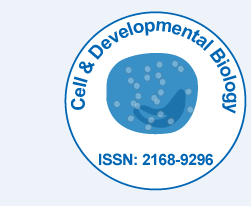
Cell & Developmental Biology
Open Access
ISSN: 2168-9296

ISSN: 2168-9296
Perspective - (2024)Volume 13, Issue 2
Methyltransferase 3 (METTL3), an enzyme involved in RNA methylation, plays a key role in modifying RNA molecules by adding methyl groups to adenosine residues, particularly at the m^6A (N^6-methyladenosine) site. This modification has been shown to regulate gene expression and various cellular processes. In the context of osteogenic differentiation, METTL3 has been found to promote the expression of critical osteogenic genes, thereby facilitating the differentiation of Mesenchymal Stem Cells (MSCs) into osteoblasts, the bone-forming cells.
Complementing the role of METTL3 is YTH Domain- Containing Family Protein 2 (YTHDF2), a reader protein that selectively recognizes and binds to m^6A-modified RNAs. YTHDF2's interaction with m^6A-modified transcripts influences RNA stability, translation, and degradation. In the context of osteogenic differentiation, YTHDF2 has been implicated in fine-tuning the cellular response by facilitating the degradation of specific m^6A-modified transcripts, thereby modulating the process of osteogenesis.
Understanding the interaction between METTL3, YTHDF2, and osteogenic differentiation provides valuable insights into the molecular mechanisms underlying bone formation and agingrelated bone disorders. This research holds potential way for the development of novel therapeutic strategies aimed at enhancing osteogenic potential and mitigating age-related bone diseases. Additionally, it indicates the significance of RNA epigenetics in regulating cellular processes and shaping the field of cellular senescence research.
To understand the complexities of cellular senescence has led scientists to uncover interesting insights into the regulation of osteogenic differentiation, the process by which Mesenchymal Stem Cells (MSCs) mature into bone-forming cells. Among the key discoveries in this field are the roles of METTL3 and YTHDF2, two molecules that have emerged as key roles in organizing cellular functions, especially in bone formation and aging-related processes.
Exploring METTL3 and YTHDF2
METTL3, a important enzyme involved in the installation of m^6A (N^6-methyladenosine) modifications on RNA, has been implicated in various cellular processes, including RNA metabolism, translation regulation, and, more recently, cellular senescence. On the other hand, YTHDF2 acts as a reader protein that selectively recognizes and binds to m^6A-modified RNAs, influencing RNA stability, translation, and decay.
Relation between METTL3, YTHDF2, and osteogenic differentiation
Recent research has highlighted the pivotal roles of METTL3 and YTHDF2 in regulating osteogenic differentiation. METTL3- mediated m^6A modification has been shown to modulate the expression of critical osteogenic genes, thereby promoting the differentiation of MSCs into osteoblasts, the bone-building cells. Although, YTHDF2-mediated degradation of specific m^6Amodified transcripts fine-tunes the cellular response during osteogenesis, ensuring proper bone formation and maintenance.
Insights into cellular senescence
Cellular senescence, characterized by irreversible cell cycle arrest and altered cellular functions, is intricately linked with aging and age-related diseases.Specifically, studies have demonstrated a close relationship between cellular senescence and osteogenic differentiation, with senescent cells exhibiting diminished osteogenic potential. Understanding the molecular mechanisms underlying this relationship is essential for indicating age-related bone disorders and improving overall bone health in aging populations.
Implications and future directions
The elucidation of METTL3 and YTHDF2's roles in enhancing osteogenic differentiation holds significant implications for therapeutic interventions targeting age-related bone diseases. By modulating the activity of these molecules, it may be possible to rejuvenate the osteogenic potential of aging MSCs and mitigate age-related bone disorders such as osteoporosis and osteoarthritis. Moreover, these findings underscore the importance of RNA epigenetics in regulating cellular senescence and tissue homeostasis, made a providence for future research aimed at understanding and targeting age-related molecular pathways.
The discovery of METTL3 and YTHDF2's roles in amplifying osteogenic differentiation represents a groundbreaking advancement in cellular senescence research. By exploring the molecular mechanisms governing these processes, scientists are assured to develop novel therapeutic strategies to resist age-related bone disorders and improve the quality of life for aging individuals. Exploration of the interaction between RNA epigenetics, cellular senescence, and tissue aging to discover new strategies for rejuvenating aging tissues and promoting healthier aging in the population.
Citation: Even MM (2024) Role of METTL3 and YTHDF2 in Enhancing Osteogenic Differentiation: A New Cellular Senescence Research. Cell Dev Biol. 13:337.
Received: 23-Feb-2024, Manuscript No. CDB-24-30784; Editor assigned: 27-Feb-2024, Pre QC No. CDB-24-30784 (PQ); Reviewed: 12-Mar-2024, QC No. CDB-24-30784; Revised: 19-Mar-2024, Manuscript No. CDB-24-30784 (R); Published: 26-Mar-2024 , DOI: 10.35248/2168-9296.24.13.337
Copyright: © 2024 Even MM. This is an open-access article distributed under the terms of the Creative Commons Attribution License, which permits unrestricted use, distribution and reproduction in any medium, provided the original author and source are credited